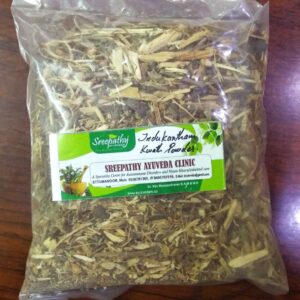Dashmool Kwath Dry
$1.69
Dashamoola, as the name signifies is the potent magical concoction of ten dried roots of ten different plants, which have been widely used in Ayurveda since ages due to its amazing health benefits.
50 in stock
Description
- Effective in joint pain and swelling
- Helps fight respiratory diseases
- Good in menstrual disorders
- Excellent restorative tonic
Dashamoola, as the name signifies is the potent magical concoction of ten dried roots of ten different plants, which have been widely used in Ayurveda since ages due to its amazing health benefits. It possesses those qualities that work in tandem for effectively offering ultimate remedies for numerous health conditions, especially the ones related to nerves, muscles, bones, joints and lungs. The word Dashamoola is Sanskrit terminology, where ‘Dasha’ means ten and ‘moola’ means root.
Call it Dashamula, Dashmulam or Dashamul, this incredible herbal remedy is not only used for pain disorders and inflammatory diseases including osteoarthritis, rheumatoid arthritis and gouty arthritis but also frequently used as an enema as it helps to alleviate constipation, anorexia, abdominal lump, bloating, flatulence, lower back conditions and inflammation in the pelvic and sacral areas. Owing to its incredible expectorant, analgesic nervine, and febrifuge actions, it is extremely significant since it helps to direct the air and space elements, i.e. the Vata doshas in the body to flow downward and alleviates most nervine disorders associated with weakness, debility and pain. It is also pivotal in case of tremors, sciatica and Parkinson’s disease. Dashamula has also been found effective in cases of dry coughs, persistent cough, breathing trouble, asthma, hoarseness (hoarse voice), chronic fever, and other health anomalies associated with respiratory weakness.
Ayurvedic Indications:
This ayurvedic medication has been named time and again in several ancient scriptures of Susruta and Charaka for the following indications including Balya (increase strength), Ama nashak (removes toxins), Svasha hara (treats asthma), Deepana (enhances stomach fire), Pachana (helps in digestion), Rochana (stimulates appetite), Hikkanigrahana (controls hiccups), Kantya (relieves sore throat), Triptighno (relieves pseudo-satiation), Kanthya (improves voice), Kapha-Vata hara (treats Kapha and Vata imbalances), Rasayani (rejuvenates the whole body), Anulomana (improves breathing), Kasahara (Relieves cough), Shotha hara (treats pain and inflammation) and Jwara hara (reduces fever).
Key ingredients
Prushniparni – Uraria picta
Bruhati – Solanum surratense
Kantakari – Solanum indicum
Gokshur – Tribulus terrestris
Bilva – Aegle marmelos
Agnimanth – Premna mucronata
Shyonak – Oroxylum indicum
Gambhari – Gmelina arborea
Patla – Stereospermum suaveolens
Shaliparni – Desmodium gangeticum
Direction
Add 10 gm powder in 160 ml water. Boil the liquid to reduce it to 1/4th of the quantity. Filter and drink warm. Honey or jaggery ( Palm Sugar) can be added as a sweetener.
Additional information
| Weight | 0.500 kg |
|---|---|
| Dimensions | 15 × 15 × 10 cm |
Only logged in customers who have purchased this product may leave a review.






Reviews
There are no reviews yet.